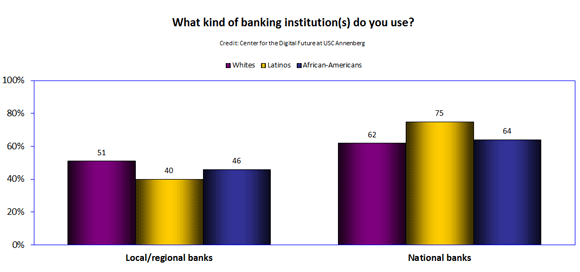In the Center’s Future of Money and Banking Study, we asked what kind of banking institutions people use: local or regional banks (associated with a city, county, state, or part of the country), national banks (like Wells Fargo, Chase, or Bank of America), or international/foreign banks.
Overall, 49% said they used local or regional banks, 63% national companies, and just 2% foreign institutions.

People with more household income are more likely to have money in national banks. Forty-nine percent of both those with a yearly household income of less than $75,000 and those with $75,000 or more yearly income said that they had money in a local or regional bank. But those with the higher household income (75k or more) were more likely to have resources in a national bank than those with less (less than 75k) by a margin of 76% to 58%.

Race/ethnicity was also related to likelihood of banking at regional or local versus national institutions. White people (51%) were more likely to say that they used local or regional banks than blacks (46%) and, especially, Latinos (40%).
On the other hand, Latinos (75%) were more likely than African-Americans (64%) and whites (62%) to say that they used national banking institutions. These racial/ethic factors may have something to do with the banking institutions available in different geographical areas.

__________
See all Web Insights.
July 9, 2018

